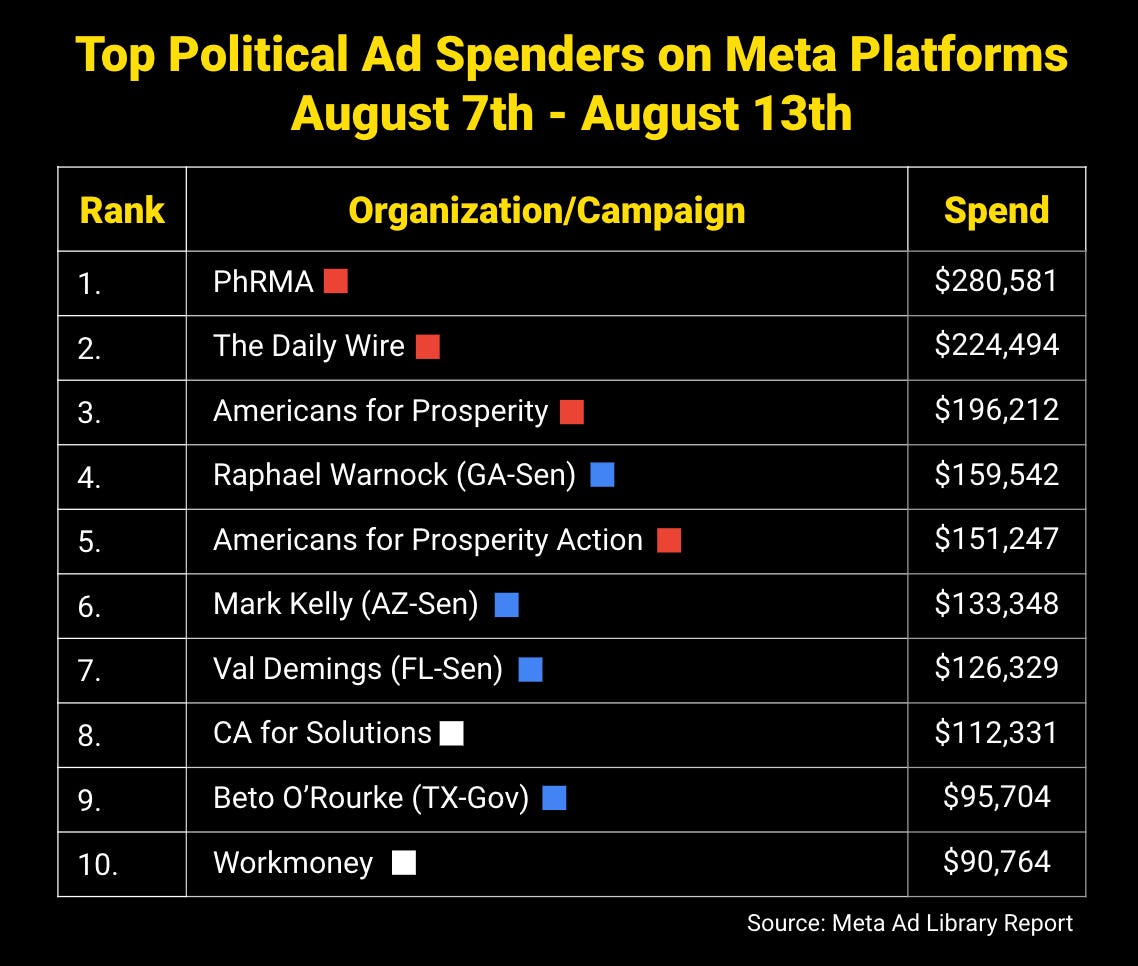Republican candidates falling far behind in digital ad spending
Also inside: Is this the first midterm candidate on BeReal?
With less than 12 weeks (!) to go until Election Day, we’ve noticed a pretty consistent trend in our digital ad tracking. Week after week, Democratic candidates in competitive Senate, House and Gubernatorial contests are outspending - sometimes dramatically - their Republican opponents. We’ll share some of that data + much more below.
But first…
By the numbers
FWIW, here were the top-spending political advertisers on Facebook + Instagram last week:
One Facebook advertiser caught our eye last week: an entity called Welcome PAC, which is targeting Ohio voters with bi-partisan messaging that they should consider “split-ticket” voting in this November’s elections. While their ad creative is pretty innocuous, the group, affiliated with the pro-democracy Welcome Party, pretty clearly would like Republican voters to support Tim Ryan for U.S. Senate over J.D. Vance. Here’s a hint that gives it away: their Facebook page name was recently changed to Welcome PAC from “University of Virginia Students for Biden.” 😂
Other new spending came from a page called Michigan Watch, attacking MAGA gubernatorial candidate Tudor Dixon. Michigan Watch is run by an entity called Put Michigan First, which is in turn funded by the Democratic Governors Association. The DGA has been running a robust program this cycle using several different brands on Facebook to reach voters in key states.
Meanwhile, here were the top political advertisers on Google platforms last week, including YouTube:
The Republican Party of Florida was one of the largest spenders on YouTube ads last week, targeting Floridians with cultish videos on behalf of Ron DeSantis. They’ve spent well over $500k in the past two weeks on these ads. That’s on top of the already massive ad spending from the DeSantis campaign itself.
… and here are the top political ad spenders on Snapchat so far this year:
From around the internet
Is Sen. Mark Kelly the first major midterm candidate on BeReal? Sort of. The Arizona Democrat shared a video this week of himself learning about the viral social media app and making a cameo in the BeReal of some grassroots supporters. Nevada Attorney General Aaron Ford chimed in too.
Boomer candidate discovers how to make Reels: former Alaska Gov. Sarah Palin is trying to make a political comeback, one of several leading candidates in the ranked-choice special/general election for Alaska’s lone congressional seat. However, all we can think about is her extremely chaotic Instagram account.
Even though we already mentioned the Dr. Oz crudités video back when it went viral months ago, it resurfaced this week and drove the political world wild once again. Dan Pfeiffer has a great piece on how little gaffes like this can turn into big problems.
Content that is shared organically on social media platforms like Facebook can have a much larger impact than paid advertising. Which midterm candidates are receiving the most reactions, comments, and shares on their campaign’s Facebook posts? Here’s a roundup for premium FWIW subscribers >>
Republicans lag digital spending across the board
The vast majority of this election cycle’s advertising dollars are still going to TV ads, but when it comes to digital advertising, Republicans are getting absolutely swamped. In competitive Senate, House, and Gubernatorial races, Democratic candidates are outspending their GOP rivals by a wide margin.
Here’s a snapshot of cumulative candidate spending on Google/YouTube and Facebook/Instagram by party in competitive races:
Obviously, the digital battle for control of the Senate is the most lopsided, with Democrats spending 5 times more on Facebook and Google ads than their opponents. In the increasingly competitive Ohio Senate race, for example, Republican JD Vance hasn’t spent more than $3,000 over the past 30 days, compared to over $300,000 from Democrat Tim Ryan. In Pennsylvania, John Fetterman has spent $170,000 to his opponent’s $7,000.
While a large chunk of digital advertising on sites like Facebook go to small-dollar fundraising ads, we’ve been surprised at how early and often Democratic candidates have been using the platforms to reach voters with informational, biographical, and persuasion content.
For premium subscribers, we have a full breakdown of historical spending data in competitive Gubernatorial >>, Senate >>, and House >> races.
Spoiler Alert in Oregon
Yesterday, a major political forecaster shifted its rating in Oregon’s Governor’s race from “Lean Democratic” to “Toss-up.” That change is due in large part to unaffiliated candidate Betsy Johnson making the election a three-way race. Our own analysis shows that Johnson has outspent both her rivals combined on digital advertising. Here’s our deeper dive into the digital dynamics of that campaign >>.
Big tech readies for the midterms
Lastly, there were several major midterm-related announcements this week from major tech companies Meta and TikTok. First, Meta announced its plans for November’s election - including bringing back a political advertising blackout in the final week of the campaign. Former Facebook staffer and friend of FWIW Katie Harbath broke down the company’s announcement on Twitter, and you can read the announcement for yourself here.
Then, on Wednesday, TikTok announced its own midterm political policies, which will supposedly include a crackdown on paid political influencer marketing. Makena Kelly at The Verge wrote about the company’s latest efforts to prep for “midterm misinformation chaos.”
One last thing
That’s it for FWIW this week, but we’re at Netroots Nation in Pittsburgh today! Stop by our training (about newsletters!) at 4:30pm to grab some FWIW stickers and meet us IRL, or shoot us an email to meet up!









Why do Republicans not advertise on Snapchat?